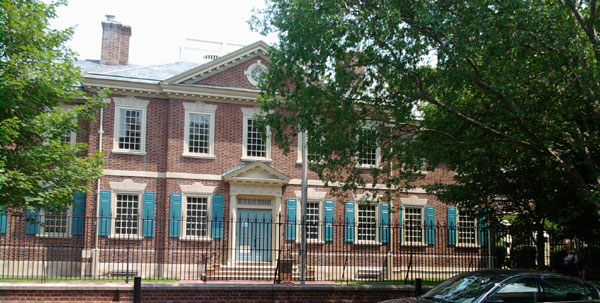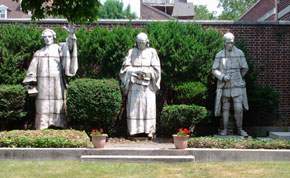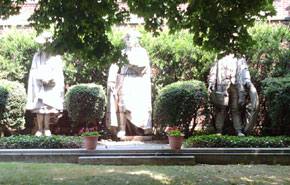The Presbyterian Historical Society

One of the keystones in the revivification of Philadelphia's Society Hill neighborhood
Founded in 1852 to "preserve and service materials relating to the history of the Presbyterian Church," the Society's library contains over 200,000 volumes and 20,000,000 manuscripts. In addition to the library, the building houses the Society's archives, a museum, and numerous portraits of key Presbyterian historic figures.
The Society's present headquarters was built in 1966-67, one of the keystones in the revivification of Philadelphia's Society Hill neighborhood. It was in Society Hill (named for a 17th-century development consortium, the Free Society of Traders) that Philadelphia's First Presbyterian Church initially met around the year 1690.
Upon entering the building one walks into the Alexander Mackie Exhibition Hall. Here the visitor finds ephemera, books, letters, and other items relating to the church's history. Also of interest are the Biblical tiles around the fireplaces which are genuine Delft reproductions of 16th-century Dutch tiles. Note, too, that the different colored paints used throughout the building are faithful reproductions of those used in the 18th century.
A clock belonging to John Witherspoon, the only active minister to sign the Declaration of Independence, serves to remind the visitor of the leadership and probity evinced by Presbyterian preachers and teachers during the time the Declaration and Constitution were being written. Witherspoon, President of the College of New Jersey — today Princeton University — had a memorable exchange with John Dickinson during a rocky session of the Second Continental Congress. Dickinson counseled caution, saying that the time was not ripe for revolt, to which Witherspoon replied, "In my judgment, sir, we are not only ripe but rotting."
Another influential Presbyterian preacher one can learn about at the museum is Francis Alison, co-pastor of the First Presbyterian Church and master of the New London Academy in Pennsylvania. James McAllister, a professor at Mary Baldwin College, analyzed the "Miscellaneous Papers" of Frances Alison at the Presbyterian Historic Society and found that of the 21 students who attended Alison's academy, two signed the Declaration of Independence, four were members of the Continental Congress, 11 held important positions in state governments, two contributed to the debates of the Constitutional Convention, and five were members of the House and Senate of the U.S. Congress.
Portraits of prominent Presbyterians painted by acclaimed artists such as Rembrandt Peale, James Peale, Bass Otis, and John Neagle line the walls of the Society. The rear of the Society contains the museum which features a fine collection of ephemera from area churches in addition to one of the largest collections of communion tokens in the world. One can view a clock face saved from the First Presbyterian Church when it was located on Washington Square, nearly century-old postcards of Philadelphia Presbyterian churches, and the earliest issues of the Journal of Presbyterian History, the oldest denominational historic journal in the United States.
GENEALOGICAL INQUIRIES
Many inquiries are made by people looking to trace their lineage through the Society's vast archive of 20,000 volumes of manuscript records of American Presbyterian Congregations. The Society is entirely dependent on volunteers to respond to genealogical inquiries. To conduct a family name search, one must know the correct name of the family's congregation, as searches are done on the basis of church membership rather than via the names of family members. Once the Society ascertains they have the records being sought, those inquiring either must continue the search in person or hire private researchers recommended by the church. Inquiries should be directed to: Genealogical Inquiries, Dept. of History & Record Management Services, Presbyterian Church (U.S.A.), 425 Lombard Street, Philadelphia, PA 19147-1516.
Upon leaving the Society, one can't help but notice the 9-foot-high statues depicting important American Presbyterian personalities which grace the garden in front of the building. They were sculpted by Alexander Stirling Calder, the man who created the 27-ton William Penn statue which tops Philadelphia's City Hall. The six statues were originally part of Philadelphia's Witherspoon Building, the one-time location of the Presbyterian Society's library. They were taken from the Witherspoon Building in 1961 and kept in storage pending the construction of the Historic Society.
 |
 |
- The museum contains one of the world's largest collections of communion tokens.
- If you want to do a genealogical search of family members, contact Genealogical Inquiries, Dept. of History & Record Management Services, Presbyterian Church (U.S.A.), 425 Lombard Street, Philadelphia, PA 19147-1516. Read above for more information.
- Location: 425 Lombard Street (Map)
- Built: 1966-67
- From a design by: G. Edwin Brumbaugh
- Tourism information: Mo-Fr 8:30-4:30, 215-627-1852
- Facilities: Small bookstore
- Official website: www.history.pcusa.org



